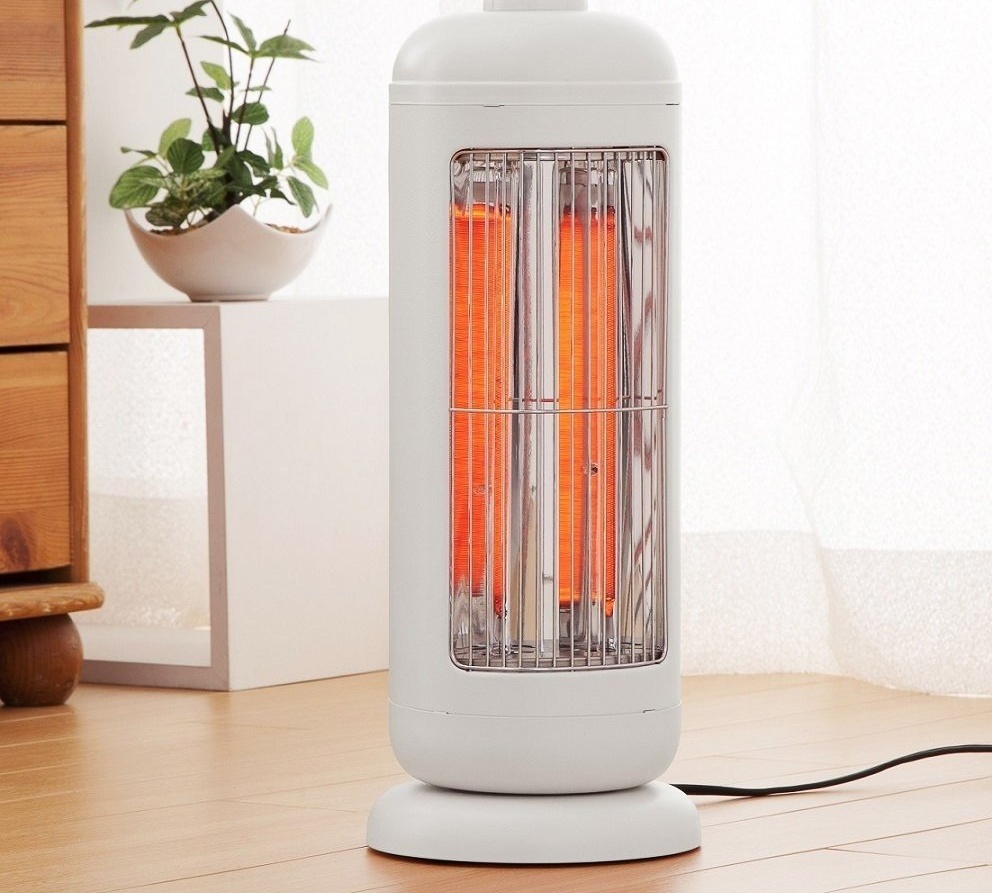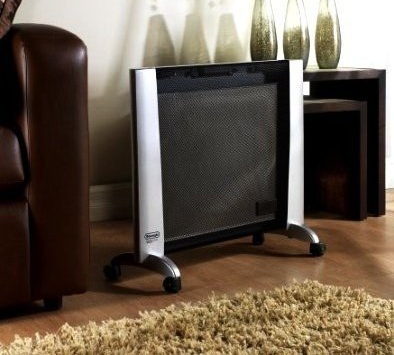Learning to choose an infrared heater: analysis of the current market supply
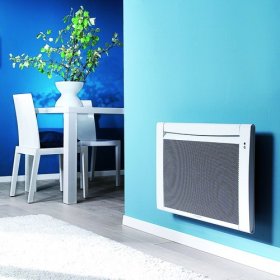
With the onset of cold weather, the issue of high-quality heating of housing becomes the number 1 topic for every person. And this is logical, because the warmth and comfort in the house is the key to a good mood and excellent health. It is not difficult to create a comfortable microclimate in an apartment or in a country house under any conditions and financial possibilities. The choice of heating equipment in stores is enormous: the unit to your taste and wallet size can always be found.
Do you want something progressive, most effective and at the same time economical? Then definitely worth paying attention to infrared heaters - unusual appliances, a real “breakthrough” in recent years in the field of heating. This equipment is shrouded in many myths, contradictions and prejudices, but, nevertheless, continues to rapidly gain popularity. And this means only one thing - this solution has a lot of advantages. Economical, aesthetic, easy to control infrared heaters: how to choose them correctly you need to know for everyone who dreams of a personal "home Sun".
Content
The principle of operation of infrared equipment
Infrared heating devices operate on the principle of infrared heating - one of the main methods of heat transfer that exist in nature. The sun heats our planet with electromagnetic waves, some of which we perceive as visible light. The same part of the spectrum that we feel as heat is longer wavelength, invisible. This is the infrared range. The infrared waves heat the surface of the Earth, from which air is subsequently heated.
Exactly the same “miracle of physics”, only in a much more modest format, can be obtained in your home - using infrared heating. Thermal radiation from infrared heaters is practically not absorbed and scattered by air; all energy radiated by devices rushes to people and objects. And objects, when heated, already in turn transfer heat to the air. Thanks to this principle of operation, infrared heating is called direct heating. Convection heating is indirect heating.
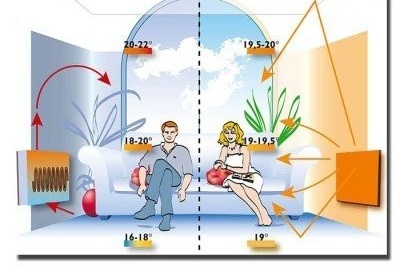
Using infrared heaters you will never encounter the problem of irrational distribution of temperature and guaranteed to reduce heat consumption and heat loss
The most comfortable temperature regime in the room is set a few hours after turning on the device. After turning off the equipment, pleasant heat does not quickly disappear - after all, walls, floors, furniture continue to give off “stored energy” for some time. And even airing the room is not a hindrance.
Structurally, IR heaters can be made in different ways, but the basis of the device of almost any device of this type is the emitter and reflector, necessary for focusing the rays in the desired direction. Radiators in electric infrared heaters actively used in everyday life can be halogen, carbon or quartz lamps, metal (aluminum) plates with heating elements of a special design, etc.
Advantages and disadvantages of such heaters
A key advantage of infrared heaters is their high efficiency. By turning on such equipment, a person begins to feel the heat almost immediately. What else do you need? The main task of any heater is to warm quickly and efficiently. And infrared units do an excellent job of this mission, without wasting energy on “intermediate media”.

From the very first minutes after turning on, an infrared heater surrounds a person with a lulling, solar-like heat - in the “company” of such a device it is always comfortable and cozy
The undoubted advantages of the equipment can also include:
- environmental friendliness (do not burn oxygen, do not raise dust, do not emit an unpleasant odor, etc.);
- profitability and heat preservation indoors;
- high efficiency;
- ease of installation;
- universality. A place where it would not be possible to successfully operate the devices, probably simply does not exist;
- lightness and mobility;
- durability;
- aesthetics;
- independence from wind and drafts.
Thanks to the swivel foot, the radiation of the floor infrared heater can be directed to any desired area - for example, to a sofa or a favorite chair. And this means that reading your favorite book or watching a movie will take place in maximum comfort. You will be warm, not a chandelier under the ceiling. Using convection-type heaters, it is impossible to achieve such a “targeted action”, since the direction of the heat flow into them cannot be regulated. And they are not warming objects, but air, "treacherously" rushing up.
True, for the sake of fairness, it is worth noting that "spot heating" is not only an advantage, but also a disadvantage of infrared heaters. As soon as you leave the “comfort zone” created by the device in the “given corner”, a huge difference in sensations sets in.
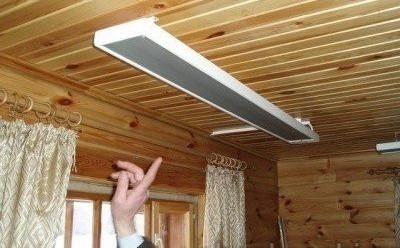
An improperly placed infrared heater can cause headaches and dry skin, so you should choose the installation location with extreme care
As a rule, a lot of controversy security issue long stay in the "range" of infrared heaters. Physicians and scientists, unfortunately, cannot come to a consensus. Therefore, the inability to be completely sure of the harmlessness of such devices is an unambiguous minus “into the karma” of equipment.
However, if you purchase units that are suitable for your needs and operate them correctly, there will definitely be no harm to your health. One wise saying says that everything is both poison and medicine, and only the dose ultimately determines what exactly we will consume. Approach the organization of heating with the help of infrared heaters wisely - and you are guaranteed to protect yourself from possible negative phenomena, which are warned by experts.
Classification of infrared units
Infrared heaters are classified according to several parameters:
- radiation range;
- source of energy;
- installation method.
Depending on the radiation range, IR units can be:
- shortwave;
- medium wave;
- longwave.
The energy source distinguishes:
- electric;
- diesel;
- gas appliances.
According to the installation method, infrared heaters can be stationary (wall, hanging, ceiling) or mobile (usually these are floor models).
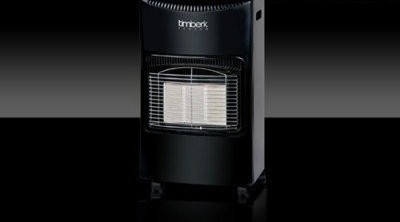
Gas infrared heaters can be used to heat outdoor areas, as well as well-ventilated living and auxiliary rooms
A wide variety of designs, options and characteristics of these units makes it possible to use them for various purposes:
- organization of the main or additional heating;
- spot heating of certain areas inside the premises;
- local heating of open spaces (playgrounds, summer cafes, etc.), outdoor and public events;
- carrying out construction work in the cold season.
Obviously infrared heaters are great solution to many heating problems.
How to choose the best model?
So, you have weighed the advantages and disadvantages of various heating equipment and decided - infrared heaters will give heat to you and your home. But how to choose from the wide range of devices of this type the most reliable and high-quality; those that will be optimal for your needs and environment?
For home use, it is better to choose electric models - quite effective, durable and safe. When buying, you must pay attention to the appearance of the design - it should "inspire confidence." One of the signs of quality products that can be appreciated even with a quick acquaintance with the units is a sturdy case, thick cable, good plug.
Never be tempted by infrared heaters with unjustifiably low cost, since many manufacturers, trying to minimize their products, stop caring about their quality: use low-quality wires, save on contacts. Needless to say, what can the permanent use of such “dubious" devices lead to? Sparking, short circuit, fire - this is the sad result of operating poor-quality units. Yes, any electrical appliances carry certain risks, this is natural, but when buying a solid branded product they are minimal.
The optimal power of an infrared heater can be calculated according to the "standard formula" - 1-1.2 kW for every 10 square meters of area.
And the main question remains, which infrared heater to choose according to the type of installation?

Recently, film infrared film heaters have become increasingly popular. What is their feature? They are lightweight, inexpensive and incredibly beautiful.
On floor units, you should stop in the event that mobility is important for you in the heaters first of all. They are an ideal choice for temporary additional heating of a summer house or apartment, when there is a need to move the device from room to room, to take it away and bring it with you. Floor IR heaters are usually equipped with an overheat protection system, as well as a trip sensor when capsizing, which makes their operation as safe as possible. This type of infrared devices, as a rule, does not have special design refinements.
Wall-mounted infrared heaters are a worthy alternative to traditional radiators. They are suitable for organizing both additional and based heating. Modern models of wall-mounted infrared heaters not only perfectly heat the room, but also have an incredibly attractive, stylish design that allows you to successfully fit them into almost any interior. The design of the external panel of these devices can be very diverse - from banal painting to natural stone finish. True, all kinds of “aesthetic delights” significantly affect the cost of equipment.
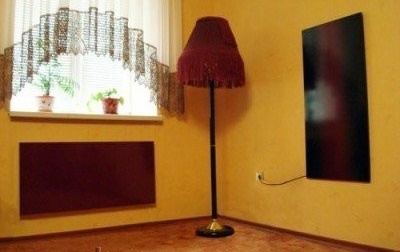
Practical, economical, with a simple design, wall-mounted infrared heaters give effective heat and delight the eye in any environment
Ceiling units - a good solution for rooms with high ceilings, office, garage, workshop. Often they are chosen for children's rooms, which is very logical - because the contact of the child with such a heating device is completely excluded. Visually, ceiling IR heaters resemble a fluorescent fluorescent lamp, and the general appearance of the room does not spoil at all.
Thermal umbrella: outdoor comfort
If you often need high-quality heating of the open space (winter picnics in the country, gardening in the cold season), a gas or electric thermal umbrella, which is one of the varieties of infrared heaters, may turn out to be very useful for you.
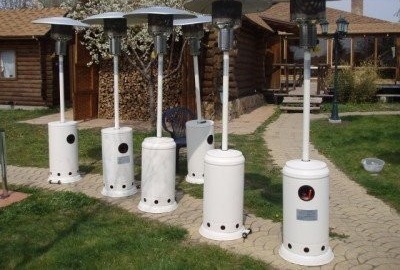
Thermal umbrellas are an excellent solution for heating open spaces. This type of infrared heaters is especially relevant for summer cafes and bars; the owners of private suburban estates also appreciated it
He is able to effectively heat a zone with a radius of 2-5 meters and give you the maximum comfort from being outdoors on any weather. Thermal umbrellas are highly stable - you don’t have to worry about being knocked over by a child or a dog.
As you can see, infrared heaters are incredibly versatile equipment that can give warmth and comfort everywhere.
